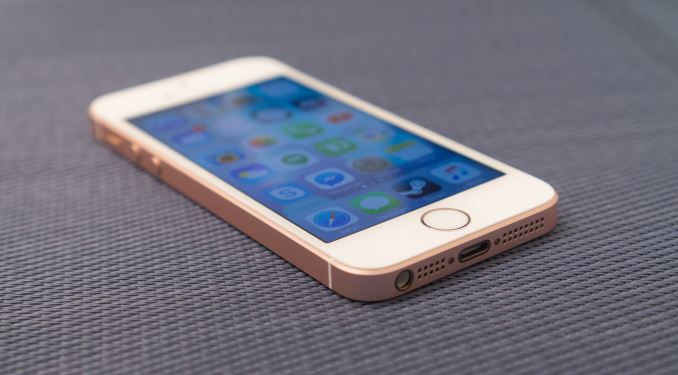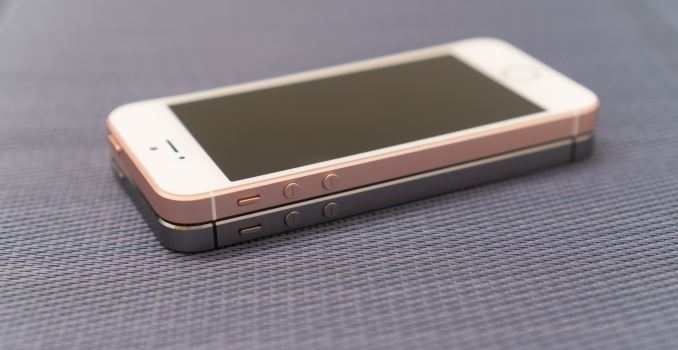The iPhone SE Review
by Brandon Chester on May 16, 2016 8:00 AM EST- Posted in
- Smartphones
- Apple
- Mobile
- iPhone
- iPhone SE
Final Words
It’s really not difficult to come to a conclusion on the iPhone SE. It’s clearly the best 4-inch smartphone on the market, and you can ignore all of the specs when making that assessment because it achieves that by virtue of being the only offering at this size. For the sake of comparison, you can take a look at some Android devices that are larger than the SE, but smaller than your average Android smartphone.
As I said earlier in the review, Android manufacturers have essentially given up on making small smartphones, and most of them haven’t actually made a top tier smartphone at the 4-inch size in about four years. By 2012 things had moved to 4.5 inches or more, with Samsung also introducing the original 5.3-inch Galaxy Note near the end of 2011. Today’s idea of a compact Android phone is something like the Xperia Z5 compact, where the screen has a size of 4.6 inches, which is just a bit smaller than the screen on the iPhone 6s. Getting an even smaller screen means moving to truly low end smartphones like the Moto E, and at that point you’re discussing two entirely different parts of the market.
Even when you consider the smallest high-end devices from the Android manufacturers, it’s not hard to see that the iPhone SE comes out on top. Apple’s A9 SoC is still one of the fastest chips you’ll find in a smartphone, and it goes without saying that the Snapdragon 810 SoC in a smartphone like the Xperia Z5 Compact really isn’t comparable in the slightest. Based on my experience, the camera is also unmatched at this size and price. It’s certainly a step behind the best Android phones and the iPhone 6s Plus, but bringing the sensor from the iPhone 6s to the SE allows for some really great photos, and the best 4K recording video you’ll get on a phone.
The 4-inch IPS display on the iPhone SE has great calibration, and in general the resolution is sufficient to avoid aliasing, although it’s obviously not as sharp as what you’ll get on many Android smartphones. My main complaint about the display is the low contrast ratio and high black level, which is definitely noticeable in real-world use when you compare to more modern LCD displays or any AMOLED panel. Apple definitely intends to keep this phone around for at least a couple of years, if not three, and it’s not going to take remotely that long for the SE’s display to fall quite a few steps behind the market. As far as future-proofing goes, the display is probably the iPhone SE’s one weak spot, although right now it’s still a nice IPS display.
Finally, we have the design of the phone. It’s really unchanged from the iPhone 5s, and some may consider that a bad thing, but I think it’s a good thing. The design still holds up, and there’s absolutely no reason to arbitrarily redesign a product every cycle. The products that are used as examples of good design are often ones that have kept the same design for many years, and in some cases many decades. I can definitely understand those who wanted a device that was more like a small iPhone 6s, but for me the aesthetics of the iPhone 5 era design come out ahead.
Ultimately, the iPhone SE is the upgrade that Apple’s 4-inch iPhone has needed for a while. Considering that it’s been over two years, it’d be hard to not improve, but the fact that you get the same performance, camera, and display calibration as the iPhone 6s is quite appealing when the phone costs $250 less. Battery life is better or worse than the 6s depending on the situation, but it’s definitely improved overall from the 5s. Faster LTE and much faster WiFi are nice improvements too, and you also have Apple Pay thrown in. There’s not much more than Apple could have included without further cutting into their margins and making it really hard to explain why the 6s is significantly more expensive. Even with the things you lose out on, I still find myself asking whether the 6s is truly worth that $250 premium.
While I’ve used the iPhone SE as my daily driver for a month, I expect that I’ll be going back to the Nexus 5X and iPhone 6s. The smaller display is just not for me, but when Apple can sell thirty million two-year-old 4-inch smartphones in a year there’s clearly demand for a smaller smartphone with high end specs. The iPhone SE delivers that, and I think users who have been holding on to an iPhone 5 or 5s should seriously consider it, because it’s the phone that they’ve been waiting for.












138 Comments
View All Comments
michael2k - Monday, May 16, 2016 - link
You're curious how much faster the iPhone SE is than the Galaxy S7? Just look for iPhone 6S and you'll see, given the SE uses the same SoC as the 6S:http://www.anandtech.com/show/10120/the-samsung-ga...
osxandwindows - Monday, May 16, 2016 - link
I can't wait for the "anandtech is so biased" comments to show up.Alexey291 - Monday, May 16, 2016 - link
Ah yes the first of the flame bait comment, so soon too...That said I did giggle at the excuse that he can't use non review data in a review. I'm pretty sure I've seen that happen far more than once. But yeah whatever. It's just a phone
extide - Tuesday, May 17, 2016 - link
That's not what he said. He said he can't use data that he doesnt have.xmrv - Sunday, May 22, 2016 - link
sheeps dont do that so you wont see any comments like that on this site...DesertCat - Monday, May 16, 2016 - link
Thanks for the article. I have some friends wanting to stick with the smaller form factor and will forward your review along.One quibble from the Experience page: "X fewer emails in the Mail app"
I'm guessing that was a place holder waiting for you to update with the number after you looked it up. May want to get that edit in. ;)
MonkeyPaw - Monday, May 16, 2016 - link
It's a little bit of a lazy effort from Apple, but it should still be a crowd pleaser. The issue is that you can get a much bigger display in the footprint of the SE. I believe the Xperia Compact is almost the same size as the SE, but can offer a 4.6" display instead. That big thumb button is really costly on Apple devices.Aenean144 - Monday, May 16, 2016 - link
No, it really isn't. The Touch ID home button has been a huge advantage, well worth the costs of poorer screen-to-body ratios. Maybe in the future the button goes away, but it has served Apple and Samsung quite well.iPhone 5/5S/SE
dimensions: 12.4 x 5.9 x 0.76 cm
footprint: 73.2 cm^2
volume: 55.6 cm^3
Xperia Z5 compact
dimensions: 12.7 x 6.5 x 0.89 cm
footprint: 82.6 cm^2
volume: 73.5 cm^3
Xperia Z3 Compact
dimensions: 12.7 x 6.5 x 0.86 cm
footprint: 82.6 cm^2
volume: 71.0 cm^3
iPhone 6
dimensions: 13.8 x 6.7 x 0.69 cm
footprint: 92.5 cm^2
volume: 59.2 cm^3
iPhone 6S
dimensions: 13.8 x 6.7 x 0.71 cm
footprint: 92.5 cm^2
volume: 60.9 cm^3
The footprint of the Xperia "Compacts" are indeed small, but both the iPhone 5 and 6 models are smaller then them in there own ways. 5/5S/SE are smaller by 10% in footprint and 25% in volume. The iPhone 6/6S have smaller volumes by 15%.
An iPhone SE will definitely feel smaller than the Xperia Compacts, while the 6/6S may feel smaller then them depending on users favoring the thinnes. The Xperias also have onscreen home, back, multitasking keys, so that 4.6" has something like 4.2" of application space for many apps.
mooncancook - Monday, May 16, 2016 - link
Partially true regarding onscreen home/back keys. On lots of apps they auto hide so the app can use the entire screen, and you swipe that area to bring the keys up.ianmills - Monday, May 16, 2016 - link
Chinese phones put the touch ID just under the camera lense. It works great (at least on bigger phones) because thats where your finger naturally rests